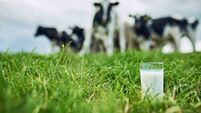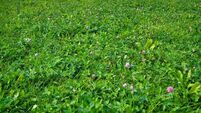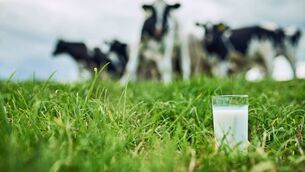The Baileys ladies: The Wicklow farm helping to produce one of the most loved Christmas beverages

Joe Hayden on his 'Baileys Farm' at Killaveney, Tinahely, Co Wicklow. Picture: Moya Nolan
In many shopping baskets in the coming weeks, you will find one of the world’s favourite alcoholic drinks, a seasonal staple and treat.
Baileys Irish Cream's origin can be traced back much further beyond its pride of place on retailer shelves, and all the way back to the farms that produce its main component.
Roughly 200m litres of Irish milk annually from about 1,500 farms is required to produce the cream used in Baileys.
This milk is supplied mainly from family-owned farms, according to the company.
Add in the Irish whiskey and some flavourings, and there you have a bottle of the good stuff.
Joe and Michael Hayden run the ‘Baileys Farm’ in Tinahely, Co Wicklow.
The farm has been in the family for well over 100 years, and is now home to the international ‘vineyard’ for the world’s number one cream liqueur, and hosts many visitors each year wishing to visit the “natural home” of Baileys.
On the farm, there are 220 ‘Baileys ladies’, Friesian Holstein cows, producing 1.5m litres of milk for Tirlán annually.
“The farm here is very typical of dairy farms up along the east coast of Ireland. We're suppliers to Tirlán, and Tirlán would have the contract to provide the cream for the Baileys factory at Nangor Road in Dublin,” Joe Hayden told the .
“We have a winter milk contract.
“Those contracts would have been developed many years ago to secure supply of quality cream for the Baileys' factory.
“You would have a significant number of farmers up this part of the world that would have winter milk contracts and we're one of those.”
Mr Hayden recalls it was around 20 years ago when the relationship began between Baileys and his farm.
“They were very mindful of the role that the family dairy farm plays in the production of cream, which is the largest single ingredient that goes into this great cream liqueur,” he continued.
“They wanted a farm where they could showcase that best in Irish dairy farming and quality cream production.
“They asked us to go on a journey with them that has been really exciting, very enjoyable, very challenging, but very good I think for both the Baileys brand and also for those of us supplying the cream there as well — it gives great recognition globally to the work that Irish dairy farmers are doing.”
As the “spiritual home” of Baileys, the farm's role is “to tell that story and bring that story of Baileys Irish Cream to a global audience”, in a number of ways.
By the time it began its partnership with Baileys in 2002, the farm already had built a visitor centre on the farm and was involved in ‘incentive tourism’, and had a lot of experience in food and drink which led Baileys to believe it might be a good partner, Mr Hayden explained.
Being able to tell the origin story of Baileys at their venue The Orchard Centre was “really important”, he said.
“We were farmers but also because we had another life working in the global tourist market, we would have an understanding of the modern discerning consumer,” he added.
The farm is certainly one that tells that story well, and is steeped in history.

Mr Hayden’s family first came to the farm in 1865.
“My great grandfather Michael Hayden was the first to come here with his young family, that was a difficult time just a few short years after the great famine of the 1840s,” Mr Hayden explained.
“The farm is now being run by my brother Michael and I, we’re working together for many, many years, and it's been a great partnership where we own a farm of 360 acres of land.”
Along with the grass-based production system, there is natural woodland on the farm and a nature reserve, “our very own wetlands”.
“Nowadays, we can recognise the huge significance of that,” he said.
“In the past, it was seen as a great resource from the point of view of wild plants, flowers, native marsh birds, things like that.
With features like these to boast, Ireland’s farms are “showcasing the best in modern food production”, according to Mr Hayden.
“It's science-based — it's a marriage of value of traditional family farming and all that is good about that, but it's embracing technology, and it's recognising our important role as custodians of our natural history and of nature,” he said.
“That comes naturally rather than something that's imposed, this was voluntarily surrendered to nature.”
Benefitting from the way the land is managed too are the Baileys ladies.
The Hayden's herd has a high EBI herd, with high solids of fat and protein, he said. They have a split calving system of 30% in the autumn and 70% in the springtime.
“That's necessary, we need that for the supply pattern for Tirlán for the winter milk contract and also to get the quality right to have the lactose levels high, etc, which is so important for the cream going into Baileys,” Mr Hayden said.
He has milked millions of cows on the farm in the past 48 years — looking after the animals is his “great passion in life”.
Mr Hayden garnered much positive attention a few years ago for playing Christmas carols to the cows, saying that there are great benefits for the herd.
“I know for most people they see the cows in the field, they’re black and white, four legs, tail and a head. If that’s all people like myself saw, we probably would have given up the ghost a long time ago,” he said.
“It is that relationship with the animals and it's the great opportunities that we have today through science-based breeding that we have wonderful, healthy, productive, fertile cows.”
Mr Hayden said his cows were very happy “because they are at one with nature, out on pasture night and day for most of the year”.
“Now science is telling us they are happy because we can actually measure that happiness through measuring the somatic cells in the milk,” he said.
“The somatic cell level is an indication of stress or subclinical infection in the cow's life.
“So by that constant monitoring, and then doing a monthly check on each cow, we can profile the stress levels of every cow.

“Stress has a huge impact on the shelf life of a product, when somatic cell counts are high.”
The happier the cow, the better the quality of the milk, the better the premium a farmer will attract, and the better the taste of Baileys in the end — everyone’s a winner, according to Mr Hayden.
“We all need to do what’s right. Regardless of economics, ethical farming is so important," he said.
However, Mr Hayden added: “I’m not suggesting for a moment we're perfect, we are imperfect.
“But with a whole-of-industry approach to doing things better, we are the envy of the world.”
The farm engages with thousands of people a year through activities such as farm visits, according to Mr Hayden.
“Many food and farm study groups from all over the world come here to the Baileys farm, to see with this immense curiosity this great story and want to engage with a farmer, spend time with the cows, and just see the reality of it for themselves,” according to Mr Hayden.
“It's immensely rewarding."
Mr Hayden believes Baileys has done a lot of good for the Irish dairy industry in terms of promotion, and also helping Tirlán suppliers in becoming more sustainable producers.
“Here at the farm, we're very proud to be associated with them,” he said.
“We’re not just reaching out to the other farmers, we’re touching the hearts and the minds of consumers all over the world.”
When those consumers come in their busloads to see the home of Irish Baileys, Mr Hayden said he could stand in his field with the Baileys ladies and feel “excitement” for this adventure he is on, and it is a “quite humbling, and wonderful” experience meeting fellow lovers of the liqueur.











